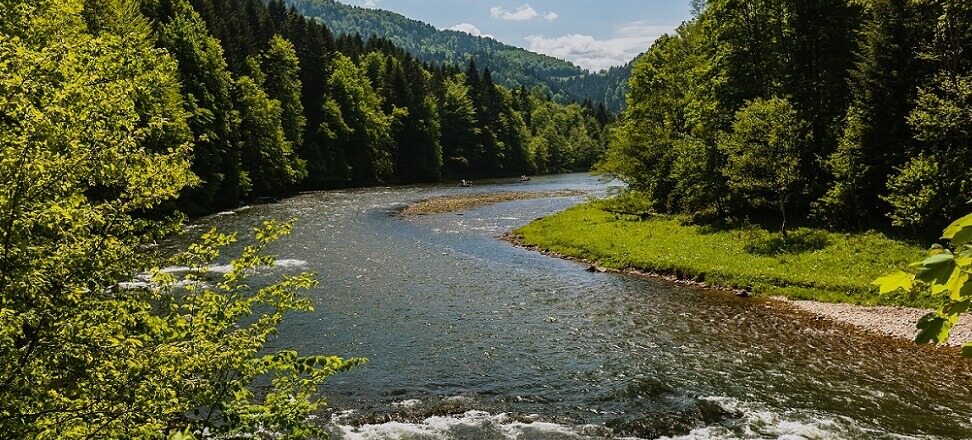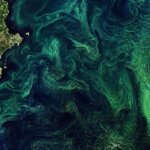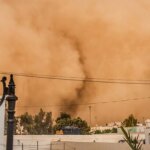Those who are confronted with the issue of water use are not unfamiliar with the concept of inviolable flow. Even without knowing its definition, we intuitively sense that it refers to the amount of water that must be left in a river when taking water from it for our own consumption, so as not to harm it. For many years, the determination of inviolable flow has been required in the preparation of water resource balances, which form the basis of water rights operations. Widely used since 1977. Kostrzewa’s method[1] includes a hydrological criterion (making the magnitude of the inviolable flow dependent on the average low annual flow and a coefficient that depends on the type of catchment area and its size) and a fishery-angling criterion (taking into account the survival of fish during spawning, development and wintering periods, and defining the inviolable flow as the lowest of the average low monthly flows during the various phases of their life). This approach required an analysis of the needs of a diverse aquatic environment in terms of ichthyofauna. It’s just a pity that the fishing and angling criterion places more emphasis on utilitarian human interest than on fish habitat conditions. However, this does not change the fact that back in the 1980s. In the 1970s. environmental flow elements have been used in water conservation in Poland (although not directly).
In 2000. the Water Framework Directive emerged, requiring far-reaching modifications in thinking and approaches to the water environment, for many still difficult to accept today. One of these changes is the need to implement a methodology for determining environmental flows, as detailed in the European Commission’s 2015 Guidance Note 31[2]. This approach requires an analysis of the environmental impact of the full range of flows, not only low flows but also high flows. For example, riparian forests in river valleys require spring periodic flooding as a prerequisite for keeping their biological life at the right level. This has often been advocated by environmentalists. Therefore, perhaps some adjustments should be made in reservoir operating instructions to allow spring snowmelt waves to pass through without being reduced to meet the needs of the environment. Nevertheless, the lower flow restriction, below which water withdrawal from the river is prohibited, is also one of the environmental flows. This element, referred to here as environmental trough flow, is the equivalent of inviolate flow, and I will devote the remainder of my discussion to it.
However, it is not the case that until the publication of the EU manual, for more than a decade of the Directive’s provisions in Poland, nothing had been done in the country to meet the regulatory requirements for inviolable flows. At the beginning of the 21st century. A method of determining the inviolable flow with consideration of the requirements of good water status, the so-called. Malopolska method (by T. Stochlinski), which met the provisions of the WFD. Both the Kostrzewa method and the Malopolska method were indicated in the now-defunct Regulation of the Minister of the Environment of April 28, 2004. (Journal of Laws 2004.126.1318) as the basis for determining inviolable flow. Somewhat earlier (again on Stochlinski’s initiative), a group of habitat methods were analyzed at IMGW Krakow, related to the conditions of ichthyofauna, specifically the IFIM(Instream Flow Incremental Methodology [3, 4, 5]), studying the effect of flow reduction on reducing the area of habitats preferred by fish.Within the framework of a project carried out at IMGW O/Kraków in 2003 – 2005 (KBN Project No. 3P04G 021 24 “Development of a genetic method for estimating the magnitude of inviolable flows, based on the IFIM method, and its application to selected surface watercourses of mountain and submontane catchments”), habitat conditions were modeled using the CASIMIR habitat model in the areas of large hydro-engineering projects under construction and design – Świnna Poręba and Kąty-Myscowa. As a result of this work, the values of inviolable flows that were assumed in water management concepts for these reservoirs were verified. Few people know that the Water Management Update for the Świnna Poręba Reservoir, developed in 2011, including a flood reserve of 60 millionm3 for normal and flood conditions contained the already verified value of the inviolable flow. It was determined using the IFIM habitat method. This is perhaps the only example in Poland of the presence in legal circulation of a water permit that contains an environmental flow (according to today’s nomenclature) that takes into account the local conditions of the ichthyofauna. This permit was in effect for only five years. In 2016, based on the regulation of the Director of the Regional Water Management Board in Krakow on the conditions of use of the waters of the upper Vistula River region, the calculation of inviolable flow based on the Kostrzewa method was returned.
Water administration in Poland also took an interest in environmental flow even before the publication of the EU manual in 2014. Between 2014 and 2018, two projects related to the determination of environmental flows for Polish conditions were carried out on behalf of the National Water Management Board, the results of which were planned to be implemented in the planning horizon of 2021 – 2027.
In the first project, carried out in 2014 – 2015, a simplified hydrological formula was proposed, in which the environmental trough flow (like the inviolable flow according to Kostrzewa’s formula) depends on the product of the mean low flow SNQ, corrected by coefficients for the so-called “low flow”. bioperiods (periods of several months covering different phases of the ichthyofauna’s existence). The coefficients were determined on the basis of field studies, using the MesoHABSIM habitat model, which takes into account environmental conditions that change throughout the year. This study was conducted in a small number of seven study catchments, covering four of the six ichthyological types proposed for Poland.
Hence, one of the goals of the second project, carried out in 2017 – 2018, was to verify and calibrate the proposed method on thirty-four study catchments. They included all ichthyological types and water catchments with different statuses (natural, heavily modified and artificial). The second major goal was to expand environmental analyses to include macrozoobenthos habitat conditions. As a result of this project, coefficients to an analogous formula to Kostrzewa’s method have been developed to determine the environmental channel flow in each body of flowing water in Poland, taking into account the conditions of fish and macrozoobenthos.
Unfortunately, to calculate the environmental flow, in addition to the coefficients, it is necessary to determine the SNQ value in a given water body. Amendment to the Water Law adopted by the Polish Parliament on September 11, 2019. assumed that only at the end of 2021 would a nationwide methodology for calculating this indicator be developed. This did not allow the calculation and use of SNQ for the 2022 – 2027 planning cycle, m. in. For determining environmental trough flows. However, IMGW-PIB has undertaken its own work in this area, issuing in 2022. A monographic study edited by Ozga-Zielinski and Walczykiewicz entitled “Methods for calculating the mean low flow SNQ.” This study can only be used in the next planning cycle.
By necessity, therefore, we have some time to prepare for the implementation of environmental flows in the next planning horizon, starting in 2028. Maybe that’s a good thing, because the problem needs additional analysis. For example, answers to several questions:
- Is the number of study catchments analyzed in the latest draft (thirty-four catchments) sufficient for the results to be applied to all water bodies in Poland, given that Kostrzewa’s method was developed on the basis of eighty-three catchments closed by water gauges?
- Is the level of possible errors in the estimation of environmental flow, resulting from the averaging of coefficients, acceptable?[6]
- What classification of watercourses should be chosen so that the set of coefficients for the environmental flow formula is optimal in relation to the measurement material at hand?[7]
- Is it necessary to count environmental flows in the lower sections of large rivers, given the small range of potential water use relative to SNQ characteristics?
- Do you go the way of the revolution and identify a method for determining environmental flows at once for all waters in Poland? Or rather, how about evolution – limit its use to natural watercourses only, and for heavily altered watercourses leave the method Fescue used so far?
It is also necessary to carry out additional substantive work, such as calculating hydrological statistics, especially SNQ, in all water bodies and preparing legislative amendments to the Water Law. It would also be highly recommended to prepare a guidebook with examples for those who perform water rights reports and the services that issue permits based on them.
Nevertheless, it should be assumed that the introduction of environmental flows is inevitable. Users should already realize that the flow restriction will be variable throughout the year, that these restrictions will sometimes be more restrictive than at present (although not always and not everywhere). This aspect should also be included in any balance models used by planners to prepare water rights statements for future water use permits.
The discussion of these issues in the scientific community is tentative for now. An example is a special panel session organized during the 4th Hydrological Congress in September 2022. Its title – “Inviolable flow – 50th anniversary of H. Kostrzewa’s method – and what next?” – gives much food for thought. Let’s hope that the discussions and achievements to date will soon be translated into concrete.
Autor jest doktorem nauk technicznych, inżynierem o specjalności budownictwo wodne śródlądowe – budowle piętrzące i siłownie wodne. Ma niemal pięćdziesięcioletnie doświadczenie zawodowe w gospodarce wodnej, w tym niemal trzydzieści w pracach naukowo-badawczych prowadzonych w oddziale krakowskim Instytutu Meteorologii i Gospodarki Wodnej, a także osiem w administracji wodnej szczebla regionalnego (zastępca dyrektora i dyrektor RZGW Kraków). Obecnie od dziesięciu lat kieruje projektami związanymi z gospodarką wodną (MGGP S.A.). Dziedziny zainteresowań – planowanie w gospodarce wodnej, sterowanie systemami wielozbiornikowymi i wielozadaniowymi w warunkach normalnych i ekstremalnych, wdrażanie dyrektyw unijnych w gospodarce wodnej, bilanse wodnogospodarcze.
In the article, I used, among other things. From the works:
[1] Kostrzewa H. 1977. Verification of the criteria and size of the inviolable flow for the rivers of Poland. Mat. Research IMGW, series: Water Management and Protection. Warsaw.
[2] European Commission, 2015. Ecological flows in the implementation of the Water Framework Directive. Guidance document n°31. Technical Report.
[3] Grela J., Stochlinski T., 2005. Application of the IFIM method to determine inviolable flow, Aura, 8.
[4] Grela J., Stochlinski T., 2004. Calculation of hydrobiological flow according to IFIM methodology.Technical Journal, T 101, z. 15 – ¶/2004 Environment, Cracow University of Technology Publishing House, pp. 39-57,
[5] Grela J., Stochlinski T., 2005.Experiments in the application of the IFIM method to the calculation of hydrobiological flow volume in the Carpathian region. Water Management 2, 52-57.
[6] Madej P., Grela J. 2021. Problems of using habitat methods to develop a hydrological formula for determining environmental channel flow – a preliminary analysis, Acta Scientiarum Polonorum. Formatio Circumiectus, 20 (2), 41-54.
[7] Grela J., Kokoszka R., 2023.Environmental flows – how to choose the right classification of watercourses, Water Management, 1, 22-30

 Polski
Polski






